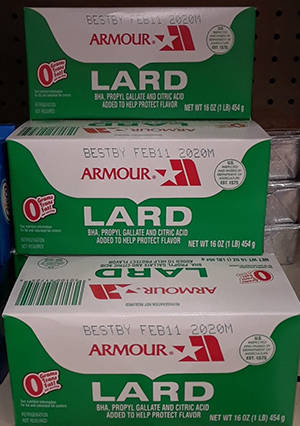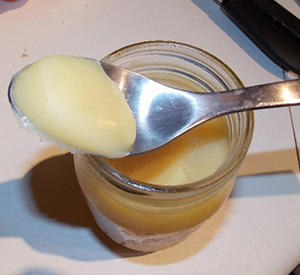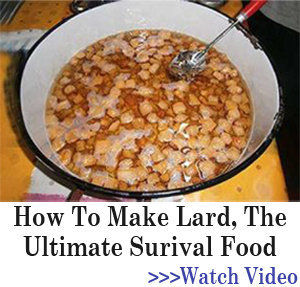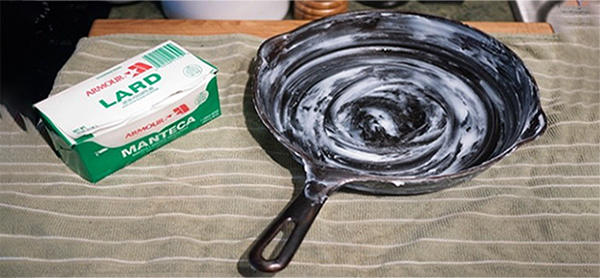My grandmother rendered lard for her family once a year when the hogs were butchered. She used that lard for cooking, baking, frying, household use, and she made the best piecrust you’ve ever tasted with it. For many generations lard was used in the same ways, but then along came cheap cottonseed oil (Crisco) and eventually other vegetable oils. We were told how healthy vegetable oils were, and how “bad” lard was for us. Advertising taught us to think of lard as unhealthy fat clogging up our arteries.
Never mind that my grandfather worked hard on the farm well into his 70’s eating food prepared with lard every day. He never suffered from the diseases caused by our modern diet. Advertising has a lot of influence on the way we think and eat.
Lard is not as unhealthy as we have been led to believe. In fact, it is lower in saturated fat than any other animal fat, including butter. It also has none of the trans-fats that we know are so bad for us. I don’t recommend that you start eating a lot of it, but it is healthier than we’ve been taught – in moderation.
Why We Should Stockpile Lard for SHTF
We need fats in our food storage. Without a little fat to help it along our food will be difficult to cook at times, it won’t taste as good, and we will need the extra calories when times get tough and we have more physical work to do.
Related: Pioneer Foods We’ll Be Eating A Lot After SHTF

Cooking Uses for Lard
#1. Lard is a valued cooking oil because of its desirable flavor and its high smoke point.
#2. Leaf-lard, considered the best for baking, is rendered from the hog’s kidneys and abdomen. It has less pork flavor and produces a grainy or flakey texture in baked goods and confections.
#3. In days gone by lard was spread on bread like butter, or even as a dip.
#4. Historically, lard has served a big role in food preservation. Meat was cooked and stored in lard through the winter until the next slaughter season. (Think duck confit.) It seems foreign to us that meat can be stored without refrigeration, but this method of food storage was frequently used in the past.
Lard for Nutrition
#5. Fat is a nutritional requirement for our bodies and is one of the four main food nutrients that should be in your food pantry. Lard provides essential calories, as well as many fat-soluble vitamins like A, D, E, and K.
#6. Fats plan an important role in keeping your skin and hair healthy, as well as its role in your healthy cell function and overall body function. Fat also serves as a source of essential fatty acids. Without any fat in the diet, you will eventually suffer from malnutrition.
Household Uses for Lard
#7. Lard is widely used a base for making poultices and salves for medicinal use. It is a good moisturizer, and protects the skin against drying, chapping, and cracking.
#8. Use lard as a hand cream to moisturize the skin.
#9. Lard, like tallow, can be used to produce soap.
#10. Lard is the best fat to use in seasoning your cast iron cookware. It does not leave behind a sticky residue like vegetable oils often do.

#11. Lard protects metals against rusting.
#12. Lard acts as a machine oil in a pinch, to keep machines oiled and moving freely. It also protects against corrosion and cools the machinery while in use. You can also use it to protect tools and weapons.
#13. Lard is flammable, and can be used as a lamp oil or as an addition to candle wax.
#14. Beef tallow and lard are good for waterproofing fabric or leather. Use either to coat your boots, rain coat or poncho. While it doesn’t form a perfect seal it does help clothing to shed water, and it prevents water from seeping into tents or other shelters when their waterproofing begins to wear thin.
Storing Lard
Lard keeps well if it is kept sealed in an airtight container. The shelf-life in the box or tub it came in is about a year or two. My most recent has a best buy date of February 2020, giving it 17 months from now. I will melt it and pour it hot into sterile mason jars, then seal it. This adds to the shelf life substantially. If you don’t want to bother transferring it to the jars, keep it sealed in the refrigerator or up to 3 years in the freezer.
Preservatives in Lard
If you purchase your lard in the grocery store it probably has preservatives in it. There are farms that produce lard without preservatives, but you will pay more for these. The lard shown in the first picture contains BHA, propyl gallate, and citric acid to preserve flavor. I’m not fond of these, so I prefer to render my own lard.
Lard is just pork fat. To render it, you cut it up into small pieces and cook it slowly to liquify the fat. I cook mine in a little water until the fat is rendered. Cooking it in water gives you a lard that is milder in flavor. Cooking it dry gives it more of the pork flavor which is nice for seasoning. If you decide to render your own lard, here is the recipe.
Why Lard?
Aside from the nutritional benefits mentioned above, lard is better suited to long-term storage than any other fat. It keeps longer than butter, vegetable oil or coconut oil and can be used in many of the same ways. Lard is comparable to coconut oil for storage and contains less saturated fat. Many doctors are now agreeing that our ancestors were right about lard. While we shouldn’t eat too much of it, it deserves a place in our storage pantries.
You may also like:
 How To Store Six Months of Food When You Only Have Space for One
How To Store Six Months of Food When You Only Have Space for One
The Only 3 Medicinal Plants You Need When SHTF (Video)
How to Prevent Your Foods from Going Rancid















If it doesn’t make a perfect seal on boots, that allows it to breathe.
I just found out they have discontinued making armour lard
After all theae years that news makes me sad and sick
I just bought 2 boxes of it last weekend at FoodLion in NC. It’s April 2022 now.
10/12/24….. My local store has a well stocked shelf, 1#, 3# and 5# sizes….
My paternal grandmother had all the bad habits cooked with lard that they rendered, ate smoked meat and plenty of bacon. She dipped snuff and had a little sip of whiskey from time to time. Made and ate homemade butter and drank raw milk. Had fresh eggs every day cooked along with homemade sausage that had been preserved in lard or hand sliced thick cut bacon. Grandmother kept two smoke houses and woe to anyone she caught in them. she passed away in 1972 and I will always believe that these habits are what done her in, just took 98 years to do it!
I remember when I was a small boy often eating bread with lard on it instead of butter. Just a little salt added to it – very tasty!
I cook with it all the time it great
Shalom Aleichem.
What’s the alternative to swine? Swine is forbidden inder Scriptual law. Don’t try to “convince” hiw “healthy” it us because it isn’t.
15 Things You Should Know About Pigs:
1). A pig is a real garbage gut. It will eat anything including urine, feces, dirt, decaying animal flesh, maggots, or decaying vegetables. They will even eat the cancerous growths off other pigs or animals.
2). The meat and fat of a pig absorbs toxins like a sponge. Their meat can be 30 times more toxic than …beef or venison.
3). When eating beef or venison, it takes 8 to 9 hours to digest the meat so what little toxins are in the meat are slowly put into our system and can be filtered by the liver. But when pork is eaten, it takes only 4 hours to digest the meat. We thus get a much higher level of toxins within a shorter time.
4). Unlike other mammals, a pig does not sweat or perspire. Perspiration is a means by which toxins are removed from the body. Since a pig does not sweat, the toxins remain within its body and in the meat.
5). Pigs and swine are so poisonous that you can hardly kill them with strychnine or other poisons.
6). Farmers will often pen up pigs within a rattlesnake nest because the pigs will eat the snakes, and if bitten they will not be harmed by the venom.
7). When a pig is butchered, worms and insects take to its flesh sooner and faster than to other animal’s flesh. In a few days the swine flesh is full of worms.
8). Swine and pigs have over a dozen parasites within them, such as tapeworms, flukes, worms, and trichinae. There is no safe temperature at which pork can be cooked to ensure that all these parasites, their cysts, and eggs will be killed.
9). Pig meat has twice as much fat as beef. A 3 oz T bone steak contains 8.5 grams of fat; a 3 oz pork chop contains 18 grams of fat. A 3 oz beef rib has 11.1 grams of fat; a 3 oz pork spare rib has 23.2 grams of fat.
10). Cows have a complex digestive system, having four stomachs. It thus takes over 24 hours to digest their vegetarian diet causing its food to be purified of toxins. In contrast, the swine’s one stomach takes only about 4 hours to digest its foul diet, turning its toxic food into flesh.
11). The swine carries about 30 diseases which can be easily passed to humans. This is why YaHuah commanded that we are not even to touch their carcase (Wayikra 11:8).
12). The trichinae worm of the swine is microscopically small, and once ingested can lodge itself in our intestines, muscles, spinal cord or the brain. This results in the disease trichinosis. The symptoms are sometimes lacking, but when present they are mistaken for other diseases, such as typhoid, arthritis, rheumatism, gastritis, MS, meningitis, gall bladder trouble, or acute alcoholism.
(In addition: One of the biggest concerns with eating pork meat is trichinellosis or trichinosis.
This is an infection that humans get from eating undercooked or uncooked pork that contains the larvae of the trichinella worm.This worm parasite is very commonly found in pork. When the worm, most often living in cysts in the stomach, opens through stomach acids, its larvae are released into the body of the pig).
13). The pig is so poisonous and filthy, that nature had to prepare him a sewer line or canal running down each leg with an outlet in the bottom of the foot. Out of this hole oozes pus and filth his body cannot pass into its system fast enough. Some of this pus gets into the meat of the pig. (This pus is the reason why pigs’ feet are so sticky when cooked)
14) According to YaHudim law, pork is one of a number of foods forbidden from consumption by YaHudim (Jews). These foods are known as “non-kosher” foods. In order for a meat to be kosher, it must first come from a kosher animal. A kosher animal must be a ruminant and have split hooves – therefore cows, sheep, goats and deer are all kosher, whereas camels and pigs (having each only one sign of kashrut) are not kosher.
15). I cannot understand why anyone would eat it. You might as well vacuum all day and then take the vacuum bag and make a nice soup out of it.”
So is there any substitute that’ll keep a long time?
Ratson Haba b’shem YaHuah
I don’t know the alternative to Lard, unless you use beef fat. Or vegetable oils.
I prefer tallow, schmaltz (chicken fat), and duck fat.
PS: Beef tallow keeps a long time. I just finished s gallon size bucket that has been on my counter for two years. I have heard keep a decade or more in a freezer. I’ve always used it up too fast to bother freezing it.
But yeah, BACON! You’ve never had a delicious bacon, lettuce, tomato sandwich. To each their own!
Ha, ha…that’s a joke. Chickens are omnivorous, also; they eat anything. We raised chickens in our back yard…they eat grass, grain, insects, dead animals, dog crap, cat crap human excrements and even human corpses in the wild…yet, they are delicious. You have to cook them thoroughly. You hear of food poisoning caused by bad chicken rather than bad pork. You can eat raw fish or beef, but never raw pork or raw chicken…cook pork all the way through…enjoy your pork and stop telling porkies…when The Lord created all animals in the 6th day He said that “it was very good”
I bet she worked hard all her life too. Like the old farmers, they didn’t sit in fancy tractors, they walked behind the bullocks
See there if grandmother had ate “healthy” she wouldn’t have died at 98,, would probably still be kicking
My granny mixed a little lard with some sulfur powder said it was better and cheaper than Prep H.
When our dog had a terrible case of mange the doctor — not the vet. I don’t think there was a veterinarian in town.
The doc prescribed flowers of sulfur, which was sulfur powder, mixed with lard to apply to the dog to cure it of the mange. He also prescribed cod liver oil in the dog’s food each time we fed him. When the mange was cured and his coat grew back it was thick and luxurious and gleamed in the sunlight.
Can’t beat something that will cure your hemorrhoids and mange at the same time!
Gotta get some. Are some brands more trustworthy than others? I want the real deal not some imitation that says lard on the package.
Not knowing where you live it’s hard to say what brands are available to you. We live in South GA and always can find it at a IGA grocery store. Amazon sells it and Armour always was a good brand. Have never seen it at a Walmart or any big grocery chain in our area. If you have any Mexican bodega’s in your area you most likely find it there in the grocery isle.
We have bodegas aplenty, but the lard isn’t pure lard, as far as I’ve seen. As with anything, it pays to read labels carefully before buying! Now, back to my lard search. I’ll probably have to order some direct…
Order pork fat at your local butcher and render it yourself
In my area, Walmart carries Armour Lard in the bake aisle near the Crisco.
Imitation? LOL
What era are we in? In Europe, in early 20th century food such as lard or sugar still often was imitation stuff. Not anymore now.
Less imitation, more mixed with non-lard stuff. I haven’t seen pure lard in a store since the 90’s in my area. I suspect it’ll make a comeback…eventually.
When you can the lard, do you pressure it or how do you seal it?
that 3 years storage longevity for the freezer is being ultra conservative – more likely 10 years – veggie oil lasts 3 years without any problems …
as article mentioned – extra fats will be welcome in a SHTF diet – especially if your meat protein is chiefly wildlife supplied ….
Oh dear God!
Do Not Buy Armour Lard!
It is awful. Check out a but her shop or Amazon but not Armour.
What about it is awful? The taste? Please elaborate.
I buy Fatworks lard from Amazon. It is wonderful. If ya don’t have access to your own pigs or a butcher shop, this is as good as home grown. They also have beef tallow and duck and goose fats. Check them out.
A question, not a comment. You write about melting it down and pouring into mason jars. I assume sealing in a hot bath? What is the shelf life when doing this? thanks!!
Have used lard forever. Absolutely makes the very best pie crust!
My grandmother ate mostly pork, and used lard for cooking. She dipped snuff and chewed tobacco. She also ate lots of vegetables. She lived to be 101-1/2 years. Before we lost her, she was the oldest of 5 generations. I miss her every day!
Look for “Hydrogenated” lard if you intend to store it. Hydrogenation bonds a pair of hydrogen molecules to the fat (or oils) to limit its chemical reactivity. The lard doesn’t become quickly rancid as untreated fat would.
I bought a pound of lard, not too long ago. It’s by the shortening. I also have about 40 pounds of beef tallow. I haven’t cooked with either, but I do use them in my body products I make for myself and family.
You can make your own, 100% lard! Go to a butcher shop and ask for their pig fat. Take it home, put it in a pot with some water and let it melt. Solids will sink to the bottom. Let it cool and skim off the fat. Let it cool and you have 100% Lard.
Only four pounds?
I am allergic to pork, to the point I have ended up in the ER with bad reactions. Now I am on medication that reacts badly with hydrogenated fats. When I was a little child our family doctor said jokingly that I should have been born Jewish.
My father knew a Jewish grocer, who was very helpful. I am still friends with his daughter, 70 years later.
ORGANIC lard is available at Wal-Mart. It has been rendered without adding bleaching agents; trans fats, or preservatives. It’s also not hydrogenated. It’s like the lard they used 200 years ago.
It is currently August 11, 2022
I bought Armor lard at my local Walmart about 2 weeks ago.
Organic lard is sold at Wal mart. It’s rendered the way our ancestors did it 200 years ago.
If you butcher your own pig; be sure to save it’s LEAF LARD. It’s fat found near the pig’s kidneys. it’s the lard our ancestors used to bake bread and pie crusts. It’s flavor’s not as intense as lard rendered from the pig’s skin .